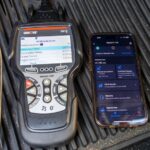Navigating the OBD2 Diagnostic Trouble Code (DTC) readiness process can be particularly challenging, especially for vehicles like the 1996 Land Cruiser. It’s a process that requires specific driving patterns over designated periods to ensure all emission monitors are set and your vehicle is ready for inspection. One critical point to remember is that any existing or pending Malfunction Indicator Lamp (MIL) codes will halt the DTC progress. Effectively, your 1996 Land Cruiser must be completely free of error codes for the readiness drive cycle to proceed.
Finding the right driving conditions to complete these cycles can be tricky. Ideally, you need routes and times with minimal traffic to maintain consistent speeds and driving conditions. Consider off-peak hours, perhaps late in the evening, to minimize interruptions. While the recommended drive cycle times are guidelines, not strict rules, the Engine Control Unit (ECU) uses an internal algorithm to accumulate data over time. Precisely when and how it counts can be difficult to ascertain.
To effectively monitor your progress, an OBD2 reader that displays live DTC status is invaluable. Tools like “Torque” or “Torque-Lite” are excellent examples, allowing you to observe the readiness status in real-time. These tools provide immediate feedback, eliminating guesswork and saving considerable time during the drive cycle.
For more detailed guidance, resources like the Lexus Technical Service Information Bulletin – READINESS MONITOR DRIVE PATTERNS, All ’96 – ’02 can be very helpful. Although branded Lexus, the principles and drive patterns often apply to Toyota vehicles of the same era, including your 1996 Land Cruiser.
A practical tip while driving is to monitor your Oxygen (O2) sensors using your OBD2 monitor. Specifically, observe the waveforms of Sensor #1 (upstream) and Sensor #2 (downstream). Typically, the upstream sensor should fluctuate rapidly, swinging between approximately 0 and 0.7 volts in a square wave pattern – this is normal operation. The downstream sensor, however, should ideally spend a significant portion of its time hovering in the mid-range, around 0.4 to 0.6 volts. It doesn’t need to be constantly in the middle to indicate a functional catalytic converter, but if it mirrors the upstream sensor’s rapid fluctuations, it suggests your catalytic converter may not be functioning efficiently, essentially acting like a straight pipe. In such cases, catalytic converter replacement or a restoration procedure like citric or oxalic acid de-scaling might be necessary. This restoration method has proven effective, even on older, high-mileage vehicles, and the difference in O2 sensor waveforms can be quite noticeable post-treatment.
In conclusion, successfully completing the OBD2 readiness cycle on a 1996 Land Cruiser requires attention to detail, the right tools like an OBD2 monitor, and an understanding of sensor behavior. By ensuring no existing DTCs, choosing appropriate driving conditions, and monitoring your O2 sensors, you can efficiently prepare your vehicle for emissions testing.
